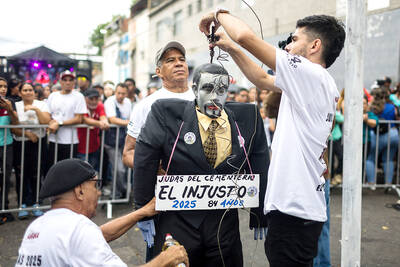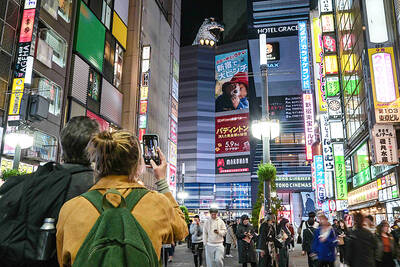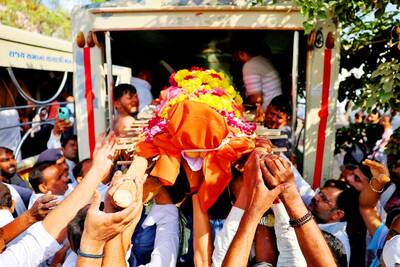They call it “the border”: the broad, snaking railway track cutting through a grimy section of the Cape Flats townships. On one side live blacks, on the other mixed-race “coloreds.”
Dumped here by the apartheid government under segregation, little has changed to integrate communities on the sandblown plains 40km from Cape Town, where grinding poverty is the only common denominator.
In Gugulethu, the black side of the track, Nomvuso Sidumo stands outside her shack made of a mishmash of materials, frowning at the suggestion of greater integration.
“No, that side is for the coloreds only. I didn’t see the blacks staying there,” she said. “We are still separated because you can’t see white people staying in shacks.”
Racial disparities inherited from apartheid are still visible, even as South Africa heads into its fourth democratic elections today.
On the Manenberg side, a bleak and deadly place ruled by gangs and drugs, overcrowded blocks of shoddy flats are interspersed by suburban-style homes — showing the preference given to the lighter-skinned people under segregation.
People of mixed-race were classified as “colored” under apartheid laws and are the largest population in Cape Town.
Winston Baadjies, 32, says little has changed 15 years after the world hailed a newly democratic South Africa as the Rainbow Nation.
“Basically it’s still the same. Nobody is coming together they are still living separately, blacks on that side, coloreds on this side and whites more in the upper class area,” Baadjies said.
David McDonald, a professor at Canada’s Queens University who spent 15 years studying segregation in Cape Town, said the problem was nationwide, but that inequality in the city was “among the worst in the world.”
He attributes this to the “economic and spatial character of segregation” and its very visual nature with the wealthy, white and cosmopolitan city of Cape Town in stark contrast to shacks that surround it.
“Rio de Janeiro, Mumbai and Jakarta all have extreme poverty and wealth, but what makes Cape Town and South African cities in general so unequal is the extent of the physical segregation,” he said.
“This is partly a legacy of apartheid with the highly spatialized character of apartheid planning ... which has very much been perpetuated by post-apartheid planning,” he said.
While walking through the bustling city center of Cape Town reveals a mixed and colorful crowd, the racial profile of poverty means most still return home to either a white, black or colored area.
“There has been so little change it is depressing,” McDonald said.
The physical separation also affects access to decent schools, healthcare and other services.
“When you look at the quality of infrastructure [in black and colored areas], it’s pathetic. Roads aren’t maintained properly and garbage collection isn’t done nearly as frequently,” McDonald said.
“Huge state resources are going into upgrading already wealthy areas ... poor areas are receiving a cup in the bucket.” he said.
Others argue gains are being made, however slowly, through policies of affirmative action, and new housing developments, which tend to be more mixed.
“Today desegregation has gone fastest in the millionaire and middle class suburbs where the new black section of the middle class is moving in,” said Keith Gottschalk, a political scientist at the University of the Western Cape.

POLITICAL PRISONERS VS DEPORTEES: Venezuela’s prosecutor’s office slammed the call by El Salvador’s leader, accusing him of crimes against humanity Salvadoran President Nayib Bukele on Sunday proposed carrying out a prisoner swap with Venezuela, suggesting he would exchange Venezuelan deportees from the US his government has kept imprisoned for what he called “political prisoners” in Venezuela. In a post on X, directed at Venezuelan President Nicolas Maduro, Bukele listed off a number of family members of high-level opposition figures in Venezuela, journalists and activists detained during the South American government’s electoral crackdown last year. “The only reason they are imprisoned is for having opposed you and your electoral fraud,” he wrote to Maduro. “However, I want to propose a humanitarian agreement that

ECONOMIC WORRIES: The ruling PAP faces voters amid concerns that the city-state faces the possibility of a recession and job losses amid Washington’s tariffs Singapore yesterday finalized contestants for its general election on Saturday next week, with the ruling People’s Action Party (PAP) fielding 32 new candidates in the biggest refresh of the party that has ruled the city-state since independence in 1965. The move follows a pledge by Singaporean Prime Minister Lawrence Wong (黃循財), who took office last year and assumed the PAP leadership, to “bring in new blood, new ideas and new energy” to steer the country of 6 million people. His latest shake-up beats that of predecessors Lee Hsien Loong (李顯龍) and Goh Chok Tong (吳作棟), who replaced 24 and 11 politicians respectively

Young women standing idly around a park in Tokyo’s west suggest that a giant statue of Godzilla is not the only attraction for a record number of foreign tourists. Their faces lit by the cold glow of their phones, the women lining Okubo Park are evidence that sex tourism has developed as a dark flipside to the bustling Kabukicho nightlife district. Increasing numbers of foreign men are flocking to the area after seeing videos on social media. One of the women said that the area near Kabukicho, where Godzilla rumbles and belches smoke atop a cinema, has become a “real

‘WATER WARFARE’: A Pakistani official called India’s suspension of a 65-year-old treaty on the sharing of waters from the Indus River ‘a cowardly, illegal move’ Pakistan yesterday canceled visas for Indian nationals, closed its airspace for all Indian-owned or operated airlines, and suspended all trade with India, including to and from any third country. The retaliatory measures follow India’s decision to suspend visas for Pakistani nationals in the aftermath of a deadly attack by shooters in Kashmir that killed 26 people, mostly tourists. The rare attack on civilians shocked and outraged India and prompted calls for action against their country’s archenemy, Pakistan. New Delhi did not publicly produce evidence connecting the attack to its neighbor, but said it had “cross-border” links to Pakistan. Pakistan denied any connection to